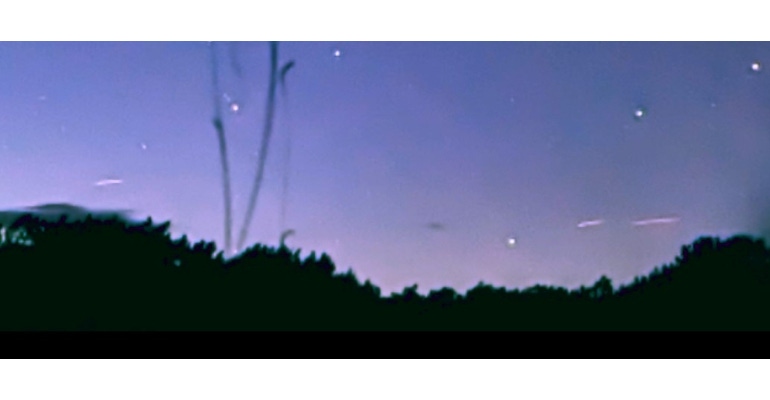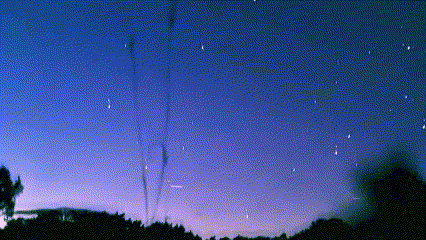UFOs at Sunset, Fighter Jets at Dawn
An engineer who enjoys solving mysteries sets out to identify some bright lights in the sky.
May 25, 2023

The kid and I had had a busy few days. She’d fished for trout in the Pecos River, and almost caught one. She’d reeled it up to the shore before it got loose. We’d contacted a half dozen people with the ham radio, both along the side of a mesa wall overlooking the Pecos right after the kid got done fishing and, a few hours later, in Cibola National Forest where we camped. It snowed the second night of our camping trip. The snow was gorgeous, but now we were both tuckered.
The kid was zonked out in her window seat. I was sitting on the aisle—it’s kind of awesome how no one will sit in your row if a kid’s there. I wasn’t quite ready to doze off, so I started to swipe through the pictures and videos I’d taken over the last few days, as one does as an adventure draws to a close.
That’s when I saw it.
In one of my videos, looking across a wooded plane at the mountains beyond our campsite, four bright objects streaked over the horizon. For all the world, they looked like fleeing UFOs.
What!?
I watched again and noticed a cloud moving from south to north across the screen. If this had been a Hollywood sci-fi thriller, it could have cloaked a mothership perfectly.

I sent off a copy of the video to my friend. His reply was immediate, although lackluster, "It’s only one second long.”
“Put it on loop, zoom in on the horizon, and watch!” I implored.
A minute later, his second reply came back, “What the . . . ?”
Satisfied I hadn't imagined the whole thing, I leaned back in my seat to ponder the facts about the video. Two nights before—the first night we’d camped, the night before the snow—I’d propped the cell phone on a rock, set a shutter delay timer, and placed it in night sight mode. Usually, if the phone’s stable and undisturbed, it takes about a four-minute ‘exposure’ that it assembles into a—here's that 'usually' again—stunning look at the night sky. Given it was a little early, the sun had only just dipped behind the mountains to the west of us, but stars and planets had begun to appear so I was willing to take my chances and hoping for the best.
The exposure was Forty… Nine… seconds. “Damn,” I thought. “That wasn’t long enough to catch anything interesting.” I picked up the phone, not bothering to even look at the picture it took. As it turned out, it hadn’t taken a picture. It’d taken a forty-nine-second-condensed-to-one-second time-lapse movie—the movie I was watching on the plane two days later.
I hadn’t noticed anything during those forty-nine seconds, but I’d been talking to the kid. I supposed the whole thing would just be a mystery. Or would it?
Gathering the Data
I remembered, in addition to the video, I had captured audio data. The kid and I had strung a ham radio half-wave dipole antenna between two trees next to our tent. I make audio recordings of most of my ham radio forays for a variety of reasons, but foremost among them is the fact that I’m not experienced enough at copying Morse code, yet run the radio, decode Morse, and take notes for a log.
I had a hypothesis about the origin of the UFOs. I remembered there had been audio data that would back it up, but had I captured it?
Ha! I found my first bit of data. The recorder had picked up a conversation the kid and I had. The data was circumstantial, but it told me where to look for the rest of the data. Here’s the conversation.
“Hey kid! Quick, put it in your ear right now.”
“MmHmm.”
“Do you hear that at all?”
“Yep.”
“That was fighter jet radar.”
“Yep.”
“Oh! Oh Cool! You know what that sounds like? ”
“Yeah, because I’ve heard it before at Za Pizza.” (Za’s our favorite pizza joint.)
“Uhhh… Right!”
I remembered that day. We’d been eating our pizza outside while I ran a few tests on the radio, so I asked, “Oh, wait, on the radio, or did I play it for you on the Internet?”
“Internet.”
“Cool.”
The kid was talking about something that had happened a few weeks before. Fighter jets—somewhat routinely—fly over our house in San Francisco. I know this for three reasons: First, their jet engines sound distinctly different than the engines of their commercial airliner brethren. Second, I’ve seen them in the skies over our house (F-22s, I think), and finally, I’ve heard their radar signals on the ham radio.
Last year, a few weeks after I got back into the amateur radio hobby, I asked a fellow engineering ham what the strange noise I occasionally heard was. He sent me a link to the High Frequency Signal Identification Wiki. It was this site I’d browsed with the kids that day. I’d heard radar and jet engines on the previous Thursday and then had seen the fighter jet itself at the same time Friday morning as I stood outside waiting for the bus. (Apparently fighter jets were on a schedule that week.)
And so, armed with the knowledge that the kid and I, in all likelihood knew exactly what those streaking lights were, I set out to find the actual evidence. I reviewed my recordings from that night. They hadn’t picked up any of the audio signatures the kid and I had been discussing. It was just Morse code and me calling out a variety of callsigns from the interior of our tent as the evening wore on until the ionosphere finally gave out for 20 meters.
I moved to the following morning's QSOs (ham radio speak for contacts made with other stations), and bingo!
I could hear the distinctive, almost cricket-like rubbing, of fighter jet radar. Had I seen the jets? Nope. But, I’d heard their engines, and now their radar. They were there and based on the evidence—almost without a doubt—that’s what the phone’s camera had seen almost fourteen hours before:
Fighter Jets
It’s fun to believe in things we haven’t observed or proven the existence of yet. It’s a lot of fun. I grew up in New Mexico, a place where lots of people saw stealth fighters before our government admitted they existed. People had so many stories about objects in the skies. It was a blast to speculate and believe.
All three of the kids here grew up watching Ancient Aliens with me—their electronics engineer, PhD Physics candidate dad—gently pointing out what ‘real’ science had and hadn’t actually shown as we marveled at the entertaining stories on the screen.
But, while it’s fun to believe, it’s also satisfying to understand what’s actually going on around us. With the abundance of data on the Internet and our apparently exponentially growing ability to collect data locally via the IoT, we can do just that. We can know.
Sometimes a UFO is a fighter jet. Both things are kind of incredibly cool for an engineer with a yearning for solving mysteries.
About the Author(s)
You May Also Like





